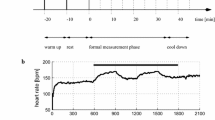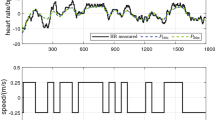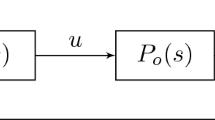Abstract
Prior studies have investigated heart rate dynamics from a variety of perspectives, but are often inadequate for predicting heart rate responses across a broad range of transient exercise intensities. The aim of this study was to develop a nonlinear model to describe the heart rate response of an individual during cycling and to investigate whether heart rate is more accurately predicted by a combination of power output and cadence than by power output alone. The proposed model can account for the transient fluctuations of an individual’s heart rate while they participate in exercise that varies in intensity. The participants for this study each performed a fifty minute bout of cycling on an electric-braked cycle ergometer in the laboratory. The testing protocol for the cycling bout was designed to challenge the predictive capabilities of the model and the participants therefore abruptly changed their power outputs and cadences throughout the tests, which resulted in significant transient fluctuations in their heart rate responses. Due to the nonlinear nature of the proposed heart rate model, a heuristic algorithm was developed to perform the parameter estimation. The model predictions for heart rate matched very well with the experimental heart rate responses for each of the participants, especially when considering the challenges inherent to predicting abrupt transient behavior in the heart rate response. Model comparisons also indicated that heart rate is more accurately predicted by a combination of power output and cadence than by power output alone.







Similar content being viewed by others
References
Johnson AT (2007) Biomechanics and exercise physiology: quantitative modeling. CRC Press, Boca Raton
Brooks GA, Fahey TD, Baldwin K (2005) Exercise physiology: human bioenergetics and its applications. McGraw-Hil, Boston
Clarke DC, Skiba PF (2013) Rationale and resources for teaching the mathematical modeling of athletic training and performance. Adv Physiol Educ 37(2):134–152. doi:10.1152/advan.00078.2011
Daniels J (2013) Daniels’ running formula. Human Kinetics, Champaign
Battaglini CL, Mills RC, Phillips BL, Lee JT, Story CE, Nascimento MGB, Hackney AC (2014) Twenty-five years of research on the effects of exercise training in breast cancer survivors: a systematic review of the literature. World J Clin Oncol 5(2):177–190. doi:10.5306/wjco.v5.i2.177
Wood WA, Deal AM, Reeve BB, Abernethy AP, Basch E, Mitchell SA, Shatten C, Kim YH, Whitley J, Serody JS, Shea T, Battaglini C (2013) Cardiopulmonary fitness in patients undergoing hematopoietic SCT: a pilot study. Bone Marrow Transpl 48(10):1342–1349. doi:10.1038/bmt.2013.58
Acharya R, Kumar A, Bhat PS, Lim CM, Iyengar SS, Kannathal N, Krishnan SM (2004) Classification of cardiac abnormalities using heart rate signals. Med Biol Eng Comput 42(3):288–293. doi:10.1007/BF02344702
Achten J, Jeukendrup AE (2003) Heart rate monitoring: applications and limitations. Sports Med 33(7):517–538. doi:10.2165/00007256-200333070-00004
Flouris AD, Poirier MP, Bravi A, Wright-Beatty HE, Henry C, Seely AJ, Kenny GP (2014) Changes in heart rate variability during the induction and decay of heat acclimation. Eur J Appl Physiol 114(10):2119–2128. doi:10.1007/s00421-014-2935-5
Givoni B, Goldman RF (1973) Predicting effects of heat acclimatization on heart rate and rectal temperature. J Appl Physiol 35(6):875–879
Givoni B, Goldman RF (1973) Predicting heart rate response to work, environment, and clothing. J Appl Physiol 34(2):201–204
Robergs RA, Landwehr R (2002) The surprising history of the HR max=220-age equation. J Exerc Physiol Online 5(2):1–10
Tanaka H, Monahan KD, Seals DR (2001) Age-predicted maximal heart rate revisited. J Am Coll Cardiol 37(1):153–136. doi:10.1016/S0735-1097(00)01054-8
Londeree BR, Moeschberger ML (1982) Effect of age and other factors on maximal heart rate. Res Quarter Exerc Sport 53(4):297–304. doi:10.1080/02701367.1982.10605252
Garcia-Ramos A, Feriche B, Calderon C, Iglesias X, Barrero A, Chaverri D, Schuller T, Rodriguez FA (2015) Training load quantification in elite swimmers using a modified version of the training impulse method. Eur J Sport Sci 15(2):85–93. doi:10.1080/17461391.2014.922621
Taha T, Thomas SG (2003) Systems modelling of the relationship between training and performance. Sports Med 33(14):1061–1073. doi:10.2165/00007256-200333140-00003
Calvert TW, Banister EW, Savage MV, Bach T (1976) A systems model of the effect of training on physical performance. IEEE Trans Syst Man Cybern 6(2):94–102. doi:10.1109/TSMC.1976.5409179
Haddad A, Zhang Y, Su S, Celler B, Nguyen H (2014) Modelling and regulating of cardio-respiratory response for the enhancement of interval training. BioMed Eng OnLine 13:9. doi:10.1186/1475-925X-13-9
Stupnicki R, Gabrys T, Szmatlan-Gabrys U, Tomaszewski P (2010) Fitting a single-phase model to the post-exercise changes in heart rate and oxygen uptake. Physiol Res 59(3):357–362
Su SW, Chen W, Liu D, Fang Y, Kuang W, Yu X, Guo T, Celler BG, Nguyen HT (2010) Dynamic modelling of heart rate response under different exercise intensity. Open Med Inform J 4:81–85. doi:10.2174/1874431101004020081
Su SW, Wang L, Celler BG, Savkin AV, Guo Y (2007) Identification and control for heart rate regulation during treadmill exercise. IEEE Trans Biomed Eng 54(7):1238–1246. doi:10.1109/TBME.2007.890738
Mavrommataki E, Bogdanis GC, Kaloupsis S, Maridaki M (2006) Recovery of power output and heart rate kinetics during repeated bouts of rowing exercise with different rest intervals. J Sports Sci Med 5(1):115–122
Bearden SE, Moffatt RJ (2001) \(\dot{V} {O}_2\) and heart rate kinetics in cycling: transitions from an elevated baseline. J Appl Physiol 90(6):2081–2087
Lefever J, Berckmans D, Aerts J (2014) Time-variant modelling of heart rate responses to exercise intensity during road cycling. Eur J Sport Sci 14(S1):S406–S412. doi:10.1080/17461391.2012.708791
Le A, Jaitner T, Tobias F, Litz L (2009) A dynamic heart rate prediction model for training optimization in cycling (P83). Eng Sport 7(1):425–433. doi:10.1007/978-2-287-99054-0_50
Zakynthinaki MS (2015) Modelling heart rate kinetics. PLoS One 10(4):e0118263. doi:10.1371/journal.pone.0118263
Stirling JR, Zakynthinaki MS, Refoyo I, Sampedro J (2008) A model of heart rate kinetics in response to exercise. J Nonlinear Math Phys 15(3):426–436. doi:10.2991/jnmp.2008.15.s3.41
Stirling JR, Zakynthinaki MS, Billat V (2008) Modeling and analysis of the effect of training on \(\dot{V} {O}_2\) kinetics and anaerobic capacity. Bull Math Biol 70(5):1348–1370. doi:10.1007/s11538-008-9302-9
Zakynthinaki MS, Stirling JR (2008) Stochastic optimization for the calculation of the time dependency of the physiological demand during exercise and recovery. Comput Phys Commun 179(12):888–894. doi:10.1016/j.cpc.2008.07.012
Zakynthinaki MS, Stirling JR (2007) Stochastic optimization for modeling physiological time series: application to the heart rate response to exercise. Comput Phys Commun 176(2):98–108. doi:10.1016/j.cpc.2006.08.005
Stirling JR, Zakynthinaki MS, Saltin B (2005) A model of oxygen uptake kinetics in response to exercise: including a means of calculating oxygen demand/deficit/debt. Bull Math Biol 67(5):989–1015. doi:10.1016/j.bulm.2004.12.005
Mazzoleni MJ, Battaglini CL, Mann BP (2015) Modeling heart rate dynamics in response to changes in exercise intensity. In: Proceedings of the ASME 2015 International Design Engineering Technical Conferences and Computers in Engineering Conference, DETC2015–47587
Mazzoleni MJ, Battaglini CL, Mann BP (2015) A predictive heart rate model for changes in exercise intensity during cycling. Med Sci Sports Exerc 47(5S):S121
Allen H, Coggan A (2010) Training and racing with a power meter. VeloPress, Boulder
Strogatz SH (2001) Nonlinear dynamics and chaos: with applications to physics, biology, chemistry, and engineering. Westview Press, Cambridge
Mann BP, Khasawneh FA, Fales R (2011) Using information to generate derivative coordinates from noisy time series. Commun Nonlinear Sci Numer Simul 16(8):2999–3004. doi:10.1016/j.cnsns.2010.11.011
Abarbanel HDI (1996) Analysis of observed chaotic data. Springer, New York
Rao SS (2009) Engineering optimization: theory and practice. Wiley, Hoboken
Miller BL, Goldberg DE (1996) Genetic Algorithms, selection schemes, and the varying effects of noise. Evolut Comput 4(2):113–131. doi:10.1162/evco.1996.4.2.113
Goldberg DE (1989) Genetic algorithms in search, optimization and machine learning. Addison Wesley, Boston
de Winter JCF (2013) Using the student's t-test with extremely small sample sizes. Pract Assess Res Evaluat 18(10):1–12
Cohen J (1988) Statistical power analysis for the behavioral sciences. Lawrence Erlbaum Associates, Hillsdale
Author information
Authors and Affiliations
Corresponding author
Ethics declarations
Conflict of interest
The authors declare that they have no conflict of interest.
Ethical standard
The experimental protocol for this study was approved by the locally appointed ethics committee, and informed written consent was obtained from each participant.
Additional information
The authors would like to acknowledge the financial support provided by the National Aeronautics and Space Administration and the North Carolina Space Grant Consortium.
Rights and permissions
About this article
Cite this article
Mazzoleni, M.J., Battaglini, C.L., Martin, K.J. et al. Modeling and predicting heart rate dynamics across a broad range of transient exercise intensities during cycling. Sports Eng 19, 117–127 (2016). https://doi.org/10.1007/s12283-015-0193-3
Published:
Issue Date:
DOI: https://doi.org/10.1007/s12283-015-0193-3




